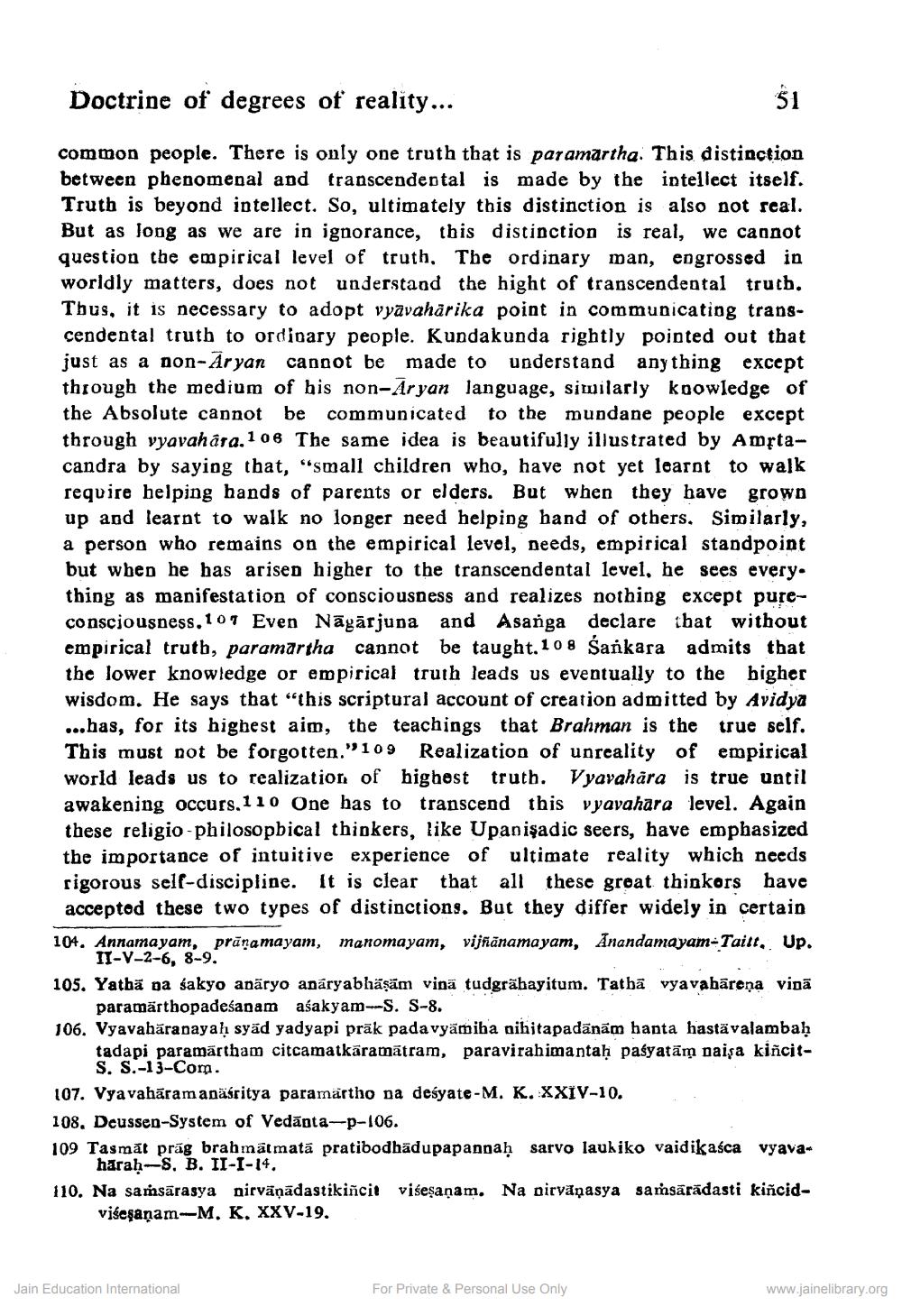________________
Doctrine of degrees of reality...
51
common people. There is only one truth that is paramartha. This distinction between phenomenal and transcendental is made by the intellect itself. Truth is beyond intellect. So, ultimately this distinction is also not real. But as long as we are in ignorance, this distinction is real, we cannot question the empirical level of truth. The ordinary man, engrossed in worldly matters, does not understand the hight of transcendental truth. Thus, it is necessary to adopt vyavahārika point in communicating transcendental truth to ordinary people. Kundakunda rightly pointed out that just as a non-Aryan cannot be made to understand any thing except through the medium of his non-Aryan language, similarly knowledge of the Absolute cannot be communicated to the mundane people except through vyavahara.108 The same idea is beautifully illustrated by Amṛtacandra by saying that, "small children who, have not yet learnt to walk require helping hands of parents or elders. But when they have grown up and learnt to walk no longer need helping hand of others. Similarly, a person who remains on the empirical level, needs, empirical standpoint but when he has arisen higher to the transcendental level, he sees everything as manifestation of consciousness and realizes nothing except pureconsciousness. 107 Even Nagarjuna and Asanga declare that without empirical truth, paramartha cannot be taught. 108 Sankara admits that the lower knowledge or empirical truth leads us eventually to the higher wisdom. He says that "this scriptural account of creation admitted by Avidya ...has, for its highest aim, the teachings that Brahman is the true self. This must not be forgotten."109 Realization of unreality of empirical world leads us to realization of highest truth. Vyavahara is true until awakening occurs, 110 One has to transcend this vyavahara level. Again these religio-philosopbical thinkers, like Upanisadic seers, have emphasized the importance of intuitive experience of ultimate reality which needs rigorous self-discipline. It is clear that all these great thinkers have accepted these two types of distinctions. But they differ widely in certain 104. Annamayam, prāṇamayam, manomayam, vijñānamayam, Anandamayam-Taitt, Up.
II-V-2-6, 8-9.
105. Yatha na śakyo anaryo anaryabhäṣām vina tudgräbayitum. Tathā vyavahāreņa vinā paramärthopadeśanam aśakyam-S. S-8.
106. Vyavahāranayaḥ syad yadyapi prāk padavyämiha nihitapadānām hanta hastāvalambaḥ tadapi paramartham citcamatkaramātram, paravirahimantaḥ pasyatām naisa kiñcitS. S.-13-Com.
107. Vyavahāramanäśritya paramartho na deśyate-M. K. XXIV-10.
108. Deussen-System of Vedanta-p-106.
109 Tasmat prag brahmatmatā pratibodhādupapannaḥ sarvo laukiko vaidikaśca vyavaharaḥ-S. B. II-I-14.
110. Na samsarasya nirvāṇādastikiñcit viseṣaṇam. Na nirvaṇasya saṁsārādasti kiñcidviseşaṇam-M. K. XXV-19.
Jain Education International
For Private & Personal Use Only
www.jainelibrary.org




